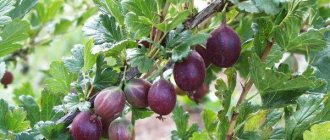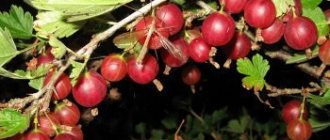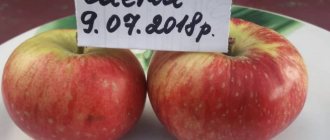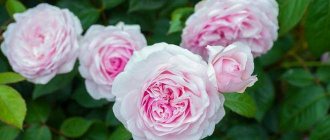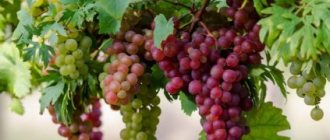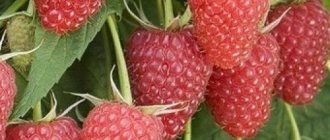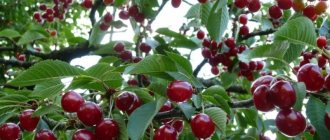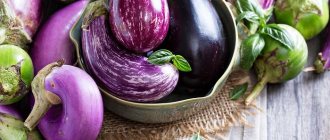There are quite a lot of raspberry varieties suitable for the conditions of Central Russia. Every gardener will be able to choose both summer and remontant varieties, as well as exotic varieties of yellow, black, and purple raspberries.
Early and mid-ripening varieties that are unpretentious to rainy, cold periods and soil fertility are optimally suited. It is also worth paying attention to heat and frost resistance, but these indicators will not be decisive, as when choosing a variety for the Krasnodar Territory or Siberia. Resistance to diseases and pests is also not of decisive importance, because Most modern varieties have good immunity, and there are more and more means of protection every year.
Feedback from gardeners allows us to form a conventional portrait of a summer resident in the middle zone. Most often, this is an amateur gardener who goes to the site only on weekends, so the varieties should be the least demanding in terms of agricultural technology, have extended fruiting periods, and not fall off when fully ripe. We tried to choose exactly these for you, but what kind of raspberries they will be: summer, remontant, standard, what color and taste - the choice is yours.
Atlant
Atlant is a highly productive remontant variety with large fruits weighing 5.0-6.0 g. The fruits are elongated, conical, dense, and can hang for a long time without falling off the fruit stalk or rotting. The beginning of ripening is the second ten days of August; before frost, the bushes manage to produce more than 70% of the harvest. Berries of universal use, sweet, juicy, fleshy. The variety is resistant to major raspberry diseases. The bushes are medium-sized, slightly spreading with good shoot-forming ability. The thorns are rare, located mainly in the lower part of the shoots. The variety is demanding when it comes to watering. With a lack of moisture, the berries immediately become smaller, as is the case in hot weather. The variety is not suitable for cultivation in the southern regions of the country; the temperate continental climate of central Russia is ideal for it
Detailed description of the Atlant variety
Apricot
Despite its unusual appearance for raspberries, this variety was developed by Russian breeders more than 20 years ago - the patent was received in 1996. Scientists have managed to create a variety that is resistant to the vagaries of weather, cold and recurrent frosts. Apricot raspberries can be grown in any region of the country, including the central zone.
Variety characteristics:
- bush height (subject to agricultural technology) - up to 1.6 m;
- crown shape - slightly spreading;
- the shape of the berries is blunt-conical;
- berry color - yellow, with a slight pink tint;
- The declared yield is up to 2.5 kg per bush.
Apricot raspberries are characterized by extended fruiting. The first berries are harvested from the beginning of August, the last berries can be harvested at the end of October or beginning of November.
The taste of the berries is pleasant, sweet with an apricot aftertaste. In rainy years and with excessive watering, the taste changes to neutral or sour. The berries do not adhere firmly to the fruit stalk and fall off easily. Therefore, the variety is not suitable for growing in dachas if the owners can rarely come.
Raspberries are highly resistant to diseases and pests. Sometimes plantings can be affected by dwarfism, a viral disease.
Morning dew
Morning dew is a large-fruited yellow raspberry variety of Polish selection. It is especially valued for its high yield, unpretentiousness, and transportability. The fruits are large (5-7 g, maximum up to 10 g), spherical, dense, dry with well-knit drupes. The taste of the berries is sweet and sour and is highly dependent on the presence of moisture. During dry periods, the sweetness is lost and the berry becomes sour. Fruiting time when grown in an annual crop: from mid-August until the first frost. The bushes are powerful, consisting of medium-sized shoots (1.5-1.7 m) with hard thorns. Optimal results can be obtained when growing the variety in an annual crop, because, provided that it is cultivated following the example of ordinary garden raspberries, the first summer harvest turns out to be much more sour than the second autumn one.
Which varieties are classified as large-fruited?
Large-fruited raspberry varieties for central Russia are popular because they are easy to collect. Large berries have excellent commercial qualities and are quickly sold out, although due to the weight of the berries, the bushes usually require high-quality staking.
- “Yellow Giant” is an attractive raspberry, the berries of which reach 12 g. Dessert type, the berries are light yellow in color, taste sugary, have honey notes, the aroma is strong, like wild raspberries.
Universal use. Up to 12.5 kg of berries are harvested from one bush! The plant is powerful, the shoots are thick, so the branches can withstand significant loads, but gartering is required. Not susceptible to disease. Frost resistance up to -30 degrees. Large-fruited raspberry varieties for central Russia
- “Bryanskoe Divo” is a raspberry variety for central Russia with large, beautiful berries up to 11 g. The shape of the fruit is oblong, the color is scarlet. Productivity 3.2 kg per bush. Fruiting is observed from the first days of August until the first frost. They brought her out specifically for the middle zone. The berries are aromatic, sweet and sour, versatile. Withstands temperatures down to -24 degrees.
- “Orange Miracle” is a unique raspberry variety for central Russia. The berries have a rich orange color, the peel is almost completely transparent. The berries are large, up to 10 g, dense. Fruiting lasts all summer, transportability is good. Universal use. The bushes are strong, but due to their significant height (up to 1.7 m), it is worth making a frame so that the shoots do not fall under the weight of the berries. It has average resistance to frost (-23 degrees) and disease.
In addition, large-fruited varieties include raspberries of the Tarusa, Ruby Giant, and Pride of Russia varieties.
Maroseyka
Maroseyka is the first thornless raspberry variety developed in Russia. The bushes are medium-sized (1.5 m), highly spreading, and require mandatory tying to a trellis. The berries are most often double, large, weighing 4-12 g, conical, light crimson, aromatic and sweet. The yield per bush can reach 4 kg. and more. Good resistance to almost all diseases.
Detailed description of the Maroseyka variety
Ruby necklace
Ruby Necklace belongs to the category of highly productive remontant raspberry varieties. It is grown on industrial plantations and private farmsteads, including on farms in the Middle Zone.
Description of the variety:
- bushes are low or medium, height 1.2–1.5 m;
- up to seven replacement shoots are formed;
- bushes are compact, there are few root shoots;
- yield per bush - up to 2.8 kg;
- yield per hectare - up to 17 tons;
- The ripening season is from early August to mid-October.
Raspberries of this variety are characterized by an uneven distribution of thorns. In the lower part of the shoot they are frequent, more rigid, in the middle and upper parts they are rare, soft, almost imperceptible. This makes it easier to tie to the trellis if necessary.
The berries of the Ruby Necklace variety are large, dense, and have an elongated cylindrical shape. They hold tightly to the fruit, which can make harvesting a little difficult. The color of the berries is bright ruby, the flesh is dense and moderately juicy. The taste is dessert, sweet and sour, the smell is pronounced and specific.
Ruby Necklace raspberries can be grown for fresh consumption, canning of all types and for sale.
Pride of Russia
The pride of Russia is one of the largest-fruited raspberry varieties selected by V.V. Kichins. The average weight of the berries is 4-12 g, some specimens reach 18 g, the shape of the fruit is conical, the drupes are small, the berries do not fall off when fully ripe, the taste is inferior to many modern varieties, for example, Patricia. The shoots are powerful, 1.5-1.8 m high, devoid of thorns. The variety is resistant to all major fungal diseases, resistant to frosts down to -30 degrees. The pride of Russia is subject to decomposition - a large number of double fruits.
Detailed description of the Pride of Russia variety
The best frost-resistant raspberry varieties
Also check out these articles
- Cucumbers in tomatoes for the winter
- Strawberry variety Gigantella
- What to feed turkey poults
- Black currant Exotic - description of the variety
In central Russia there is a long summer. But no matter how warm it is, harsh winters are quite natural here. Therefore, raspberry varieties for central Russia must have good winter hardiness.
- “Gussar” is a variety that is resistant to cold snaps and temperature changes, but is not remontant; frosts down to -35 degrees are not scary for it. 3.5 kg of berries from the bush are collected annually. The berries ripen from the beginning of July. The fruits are of medium size - 4 grams each. Transportability is acceptable - it can withstand medium-length transportation. The bushes grow up to 2.5 meters, so they are usually grown near trellises. It is rarely affected by diseases, but prevention does not hurt.
- "Cumberland" is an American variety.
Not afraid of frosts down to -34 degrees. The berries are black, round, up to 2 g. Up to 10 kg can be collected from a bush annually, with good agricultural technology. The bushes are quite tall, the branches grow up to 3 meters, thorny. They are usually grown on a trellis or with high-quality tying. It can be transported without problems, keeping quality is normal. The taste is sweet, there may be some sourness if there was not enough sun. The berries are very tasty, a little unusual, the seeds are small. The best frost-resistant raspberry varieties - “Pride of Russia” is a frost-resistant raspberry variety for central Russia that can withstand temperatures down to -30 degrees. The berries are large - up to 12 g, bright crimson. Productivity – 4.2 kg/bush. Transportability is not very high, but raspberries will withstand short transportation. Bushes of compressed type, high - 1.8 m, need support and garter. Many new shoots are formed during the year, so there will be no problems with reproduction. Not affected by fungal diseases.
- “Tarusa” is a variety with large, beautiful berries up to 13 g. The color is rich, scarlet, barrel-shaped or irregular. Can be transported over long distances, the taste is not bad. Productivity up to 4.1 kg per bush. Frosts down to -30 degrees are not scary for him.
- "Penguin" is resistant to frosts of more than -26 degrees Celsius. The berries grow up to 4 g, scarlet, regular in shape. The plant grows up to 1.4 m, is not spreading, the shoots are elastic and thorny. Productivity – 2.5 kg/bush. The taste is very good, sweetish. The amount of sugar and acid depends on the place where the raspberries are planted and the amount of sun that falls on them.
- “News Kuzmina” is a winter-hardy raspberry variety (-25 degrees). The plant is medium length, spreading, with thorns. Productivity – 1.5 kg/bush. The berries are 2.5-4 g, but tasty, sweet, round in shape. Requires annual treatment against harmful insects and diseases.
This also includes: “Dnepr-2”, “Yellow Giant”, “Indian Summer”, “Elegant”.
Galaxy
Galaktika is a mid-early raspberry selected by V.V. Kichins. The berries are large, have a dessert taste, but have a thin skin on the drupes, which does not allow the harvest of this variety to be transported over long distances. The characteristics of the variety from advertising brochures and from reviews of gardeners vary greatly. According to verified data, the yield is 3-4 kg. from the bush, according to the stated up to 18 kg. The fruits are on average 4-6 g, according to the stated: 18-20 g, but this is more likely the size of a strawberry and photographs of raspberries of this size are not found anywhere. Standard-type bushes, powerful with increased shoot-forming ability. Agricultural technology is standard, similar to other summer varieties. Some shoots (up to 20%) may show signs of remontancy, forming an autumn harvest at the tops of the shoots. The disadvantage of this variety is the small number of real reviews.
Detailed description of the Galaxy variety
"Arbat" - large-fruited mid-early raspberry variety
The Arbat raspberry variety is one of the varieties with the highest yield. It has large berries (up to 20 grams) of rich red color. The fruits are dense and easily tolerate storage and transportation. The yield of the bush can reach up to 10 kilograms of fruit per season. The complete absence of thorns on the stems of the plant greatly facilitates harvesting. A minimum of care to combat pests and various diseases - the variety has good resistance to them. If you want to increase the yield up to two times, we recommend regular use of fertilizing. Ripening begins in July and continues until mid-August. Fruiting occurs every year. For the winter, the variety needs to be covered.
Indian summer
Indian Summer is a proven variety of remontant raspberries that has been tested over the years. The berries are not very large, not the sweetest, the yield is low, but the variety is stable and has taken root in many garden plots. Fruiting begins in mid-August and continues until frost. The assortment has continued selection in the form of the Indian Summer-2 variety, which is sweeter, more productive, and larger-fruited, but is also inferior in these indicators to many modern varieties. Examples are often given of the Polka, Firebird, Orange Miracle, and Joan G varieties, to which Indian Summer-2 is inferior in a number of characteristics.
Detailed description of the Indian Summer variety
Varieties of remontant raspberries
According to gardeners, remontant raspberries are the best representative of the genus : the harvest can be harvested several times a season, the berries are large, and fruiting is abundant. I just want to replace all traditional varieties with remontant ones and enjoy delicious, aromatic berries all summer long.
Let's consider varieties of remontant raspberries of early, medium and late ripening.
With proper care, these varieties bear fruit almost continuously.
Abundant
Izobilnaya is a very productive variety of summer raspberries, but many people speak negatively about its taste and transportability. In addition, the variety has a tendency to bake in the sun, so Izobilnaya is not suitable for the south of Russia and is cultivated mainly in the middle zone. The bushes are very powerful, without pruning they can reach a height of 3 m and above. The laterals are long, growing up to 40-50 cm. Requires bending down for the winter, without proper shelter it can freeze even at a temperature of -25 degrees.
Detailed description of the Izobilnaya variety
Frost-resistant remontant varieties for the Middle Zone
“Double-yielding” varieties that have all the varietal characteristics necessary for the middle zone include:
Hussar
The remontant variety Gussar tolerates any cold and sudden temperature changes well. The bush is capable of producing up to 3.5 kg of raspberries. The first harvest berries appear in early July.
The weight of the fruit is about 4 g. The crop tolerates transportation well over medium distances.
Plants can grow up to 2.5 m, so they need additional support. They rarely suffer from diseases, but taking preventive measures will not be superfluous.
Penguin
An early-ripening remontant variety is capable of not dying in frost of 26°C. The weight of the berries is 4 g, the color is bright scarlet, the shape is regular. The bush grows up to 1.4 m, the degree of spreading is average.
Penguin shoots are elastic, with a moderate number of thorns. One plant can bear up to 2.5 kg of fruit. The ratio of sweet and sour taste components depends on where the raspberry grows and the amount of ultraviolet radiation it receives.
More on the topic: Purple raspberry variety Glen Coe
Mirage
The height of the bushes of the mid-late harvest variety Mirage is 1.8-2 m, the thorns on them are short and straight. The berries have a cone shape and weigh 10-12 g; accordingly, Mirage is also large-fruited. In addition, it is remontant and winter-hardy.
The fruits are very juicy, sweet and sour in taste, and resemble wild raspberries. They do not dry out in the sun and do not become watery after rains. They can be consumed in their natural form and preserved for the winter.
Diamond
Brilliant is a thornless, highly branching raspberry variety with low stems (up to 1.5 m), similar in appearance to currants. The berries have an excellent presentation, but a mediocre taste and are practically devoid of aroma. It forms few root shoots, does not “spread” over the area, but reproduces poorly. It bakes heavily in hot sunny weather, the drupes are poorly bonded and fall apart when harvested; with timely watering, this drawback is leveled out.
Detailed description of the Diamond variety
"Glen Ample" - a mid-late standard raspberry variety
This variety, native to Scotland, is more commonly called “raspberry tree.” This name is due to the fact that the bush grows very powerful, with a complete absence of thorns. The length of the shoot can easily reach 3 -3.5 meters. It is resistant to drought and frost, does not even require shelter for the winter, and quite successfully “holds” temperatures down to minus 30 degrees. In addition, it copes well with diseases and pests. Requires minimal care when growing.
The harvest of delicious berries, up to 10 grams, may well be up to 2 kilograms of raspberries from each large shoot. In early spring, the first harvest is possible already at the end of June; the bush bears fruit throughout July.
Niwot
Nivot is a remontant chokeberry variety bred in the USA. The bushes are powerful, of medium height (about 1.7 m), thorny. The berries are round, weighing 3.0-3.5 g, black with a bluish bloom, aromatic. The variety does not produce shoots; it reproduces, like blackberries, by rooting the tops. In terms of ripening time - medium early, it manages to produce almost the entire harvest before frost. Productivity is high. A garter to the trellis is required.
"Brigantina" - a mid-late raspberry variety
Compact, erect plant with a minimum number of thorns on the stems.
Ripening begins almost in August, from the third decade of July. With a maximum berry weight of up to 4 grams, the yield from a bush can reach 2.5 - 3 kilograms of fruit per year.
The most valued feature of this variety by gardeners is its high resistance to frost and drought, which is very important for the middle zone. An additional advantage is the high resistance to diseases and pests such as anthracnose and spider mites. This variety has been known and faithfully served by many gardeners for decades, and continues to enjoy well-deserved popularity, despite the increasing number of new products appearing.
Glen Coe
Glen Coe is a dark purple raspberry variety that is often placed in the same line as black-fruited varieties. The bushes are thornless, medium spreading, do not form shoots, and do not “spread across the area.” The berries are medium-sized, spherical, dark purple with a waxy coating (dark ruby inside), lacking the characteristic raspberry aroma, but tasty and sweet. When feeding with potassium-magnesium complexes, the taste of the berries improves significantly and their size increases. Winter hardiness is high, it reproduces by rooting the tops. Refers to ordinary summer varieties and does not show signs of remontancy. The laterals and “fruits” are long; double pruning according to Sobolev is not carried out, otherwise the bush will be too thick.
Detailed description of the Glen Coe variety
"Meteor" - an early raspberry variety
To quickly obtain results, use the Meteor variety. The first fruiting begins at the end of June and lasts up to two to three weeks. As a result, up to 2 kilograms of berries are harvested from one bush. The bush is not spreading; shoots up to 2 meters in height do not need to be tied up. It is not necessary to cover for the winter; just bend the shoots to the ground. Quite resistant to many fungal diseases.
Bristol
Bristol is a proven variety of large-fruited black raspberries. The bushes are compact, straight-growing, covered with a large number of thorns. The berries are larger than Cumberland (3-4 g), spherical in shape, black in color. The drupes are well adhered, the berries are easily removed from the stalk, do not crumble or wrinkle when picked. The taste is sweet with a blackberry aroma. The ripening of berries is uniform; again, when compared with Cumberland, the fruiting period is much shorter. The fruits are universally used, good for fresh consumption, processing and freezing.
Detailed description of the Bristol variety
The best varieties of yellow raspberries
This is a rare guest in summer cottages, but in taste and appearance it is not inferior to the standard and familiar red raspberry. It is consumed fresh and thermally processed - jam, pies, compotes, jams. VyborExpert specialists studied 6 candidates for the title of the best varieties of this type and, by comparing their effectiveness, versatility in preparation, ease of care and accessibility, added 2 of the most popular plants to this section of the rating.
Yellow giant
The raspberry variety “Yellow Giant” primarily stands out in the ranking for its yellow color. It leads among competitors in terms of yield and forms fruits even on one-year-old shoots, although only on the tops. The plant appeared by crossing Maroseyka and Ivanovskaya in 1979. This is an excellent option for allergy sufferers, because the chemical composition does not contain the natural dye anthocyanins. It is also recommended for pregnant and lactating women.
This is one of the best raspberry varieties for the south, growing up to 2 m in height, but its branches do not spread widely, so the plant does not require too much space. The bushes have small thorns and this makes harvesting quite comfortable. 13 or more berries are formed on the shoots. Its fruits are large - weighing up to 8 g, elongated in shape and pale yellow in color. They are characterized by a pleasant aroma and sweet taste, so when preparing jam and compote you do not need to add a lot of sugar.
Advantages
- Small and not hard seeds;
- Dietary value;
- Also plays a decorative role;
- Rapid development of the root system;
- The fruits are not empty inside.
Flaws
- Not the best transportability;
- Short shelf life - up to 1 week.
It is recommended to plant raspberry seedlings in the fall, in pre-made trenches. To do this, you should choose well-lit and elevated areas.
Orange miracle
Raspberries "Orange Miracle" appeared in Moscow, at the Institute of Horticulture and Nursery Growing. The plant is a remontant plant that bears fruit twice a season. The first fruits can be collected after July 10, and the second harvest occurs at the end of August. The bushes provide berries until frost. The berries can be consumed raw and thermally processed - jam, compote, etc.
The orange miracle is distinguished by large fruits up to 4 cm long and weighing about 8 g. They taste sweet, with a not pronounced sourness. This combination is explained by the balance between the amount of sugar and acid. The aroma of the berry is not strong, but pleasant. Raspberries have a golden color that varies from yellow to orange, depending on the stage of ripening. Harvesting in autumn accounts for up to 70% of production. Up to 2-3 kg are collected from one bush.
Advantages
- Generous harvest;
- Minimum likelihood of parasite infection;
- Resistant to various diseases;
- Cutting off shoots at the end of fruiting protects the berries from pests;
- Usually fully ripens before the first frost.
Flaws
- Moisture-loving - with a lack of water, the size decreases;
- If you water too often (more than 3 times a week), the susceptibility to fungal infection increases.
Reviews indicate elastic and dense pulp that does not crack during the berry picking process. They are characterized by a velvety surface and good transportability.
Zeva
Zeva is a productive remontant variety originally from Switzerland. The berries are medium-sized (about 3 g), bright red, round, sweet and sour, aromatic. Tasting score 4.1 points out of 5.0 possible. The fruits are smooth, beautiful, and do not fall off for a long time even when fully ripe. Fruiting period: from the first ten days of August until the first frost. The bushes are medium-sized (1.5-2.0), medium thorny. The shoots are erect and form a crop along their entire length. Winter hardiness and drought resistance are high. Shoot-forming ability is high. The variety is easy to propagate, but without timely care, it can spread throughout the area. A distinctive feature of Zeva is the peculiar consistency of the fruit. The berries are slightly chewy and stick a little to the teeth when consumed.
Popular raspberry varieties with photos and descriptions
In order to reap a rich harvest of raspberries, you must properly plant and subsequently care for the plant. At the initial stage, during preparation, you should choose a raspberry variety that will grow on the soil of the region in which planting is planned.
Top best raspberry varieties
Since each raspberry variety has certain requirements for temperature, climatic conditions, and soil characteristics, it is better to choose universal varieties that perform well in any conditions. Today, there are the best varieties of raspberries, which are popular among most gardeners in the country.
The most popular and, perhaps, sustainable varieties of berries include:
- "Hercules". These berries represent large-fruited raspberry varieties and are distinguished by excellent resistance to frost and various diseases. The berries of this raspberry variety are very large in size and weight, about 12 grams. The taste qualities are also not inferior to external characteristics and are distinguished by their pleasant sweet and sour taste.
- "Cumberland". This variety is very often confused with blackberries, because the berries of these raspberries have an almost identical appearance. The harvest from such a berry bush can be harvested throughout almost the entire summer. In addition to their unusual appearance, the berries have a very pleasant aroma and sweet taste. An additional bonus of this variety is that the bushes do not have thorns.
- "Yellow Giant" Tall raspberry bushes of this variety are distinguished by good endurance and average yield. Large sweet berries have a non-standard color and almost no seeds.
- "Dnepr 2". This variety is popular not only because of its excellent external and taste characteristics, but also because of its ability to produce crops twice a year.
- "The Pride of Russia." The flashy name fully corresponds to the raspberry variety, since the berries of this raspberry are fragrant, large in size, and bright red in color.
But as mentioned above, not all raspberry varieties are accepted in certain areas. Therefore, before purchasing a particular bush, you should ask whether it will grow in a particular region.
The best raspberry varieties for growing in the Moscow region
So, in order to choose the best raspberry varieties for the Moscow region, you should know that this region is characterized by early frosts. Based on this, we can conclude that in areas of this area it is best to plant remontant raspberry varieties that cope well with frost. Many years of experience of gardeners near Moscow have shown that the following raspberry varieties bear fruit best in this region:
- "Diamond". Complete absence of thorns on the bushes, beautiful large sweet berries with a red tint, the best variety that can be planted in a plot near Moscow.
- "Polka". This is one of the popular varieties in the Moscow region, thanks to its record yields. The raspberry variety “Polka” appeared with the help of Polish experts who crossed two varieties that were different in their characteristics. This raspberry variety belongs to the remontant species, which, having a significant height, is absolutely easy to care for. A special feature of this variety is its resistance to gray rot, spider mites and other diseases, since the peak of fruiting of the bush occurs quite late - early August. The variety's resistance to frost is reflected in its ability to bear fruit for a very long time. It is because of this feature that such raspberries are called profitable. Large, dense berries of almost scarlet color have a pronounced raspberry aroma, sweet and sour taste and excellent transportability. Many housewives prefer to freeze the fruits of this variety because after defrosting they do not lose their natural shape.
- "Hussar". Like all representatives of the remontant type, this variety is resistant to cold and easily tolerates it. Fruit ripening begins in July. When ripe, the berries are dark red in color. The peculiarity of the variety is that it is very easy to grow; raspberry bushes do not require staking.
- "Amber Sadko" This raspberry variety is a variety of yellow raspberry. August can be called the peak of fruit ripening; it is during this period that large, sweet berries ripen on the bushes, which are about 2 meters in height.
- Raspberry “Patricia” description of the variety: the bushes tolerate frost well and can withstand temperatures down to -30. But in the Moscow region it is better to protect the bushes and bend them down for the winter. Raspberry "Patricia" was bred in 1986 in Moscow and adapted to the local climate. The bushes bear fruit annually and mainly in the first ten days of July, so the variety can be called early. The berries have a beautiful canonical shape and a pleasant velvety surface. Since these raspberries are large-fruited, the berries reach from 4 to 12 grams in size. The fruits are dense and do not crumble when picked. The taste is sweet and the aroma is pronounced raspberry. A few seeds are buried in juicy pulp. These raspberries are best consumed fresh, but they are also ideal for processing and canning.
In addition to these varieties, almost all varieties of remontant raspberries will be grown on the lands of the Moscow region and will produce an excellent harvest.
Raspberry varieties for varied climates in the middle zone
In order to choose raspberry varieties for the middle zone, you should pay attention to berry bushes that can withstand sunny, dry and hot summers, as well as the harsh frosty winters of this region.
But, despite such climatic indicators, local summer residents grow almost all known varieties in their gardens; among the popular ones were the following:
- "Atlant". This variety is characterized by increased productivity and special resistance to frost. The fruits of these raspberry bushes are sweet and dense.
- "Early Surprise" The name of the variety speaks for itself; indeed, the berries on the bushes ripen quite early. But despite this they taste very sweet. The berry itself has a ruby color and an oblong shape.
- "Kuzmin's News". A specially bred variety has bright and sweet berries, the size of which is more than 5 grams. This variety takes root very well in the middle zone because it has high frost resistance, as well as an average stable yield.
- Raspberry “Bryanskoe Divo”, description of the variety: Gardeners unanimously claim the unique properties and unpretentiousness that distinguish this variety. It is obtained due to open pollination. Large-fruited raspberry varieties are best reflected in this remontant type of berry. This variety bears fruit late, in the second decade, but, despite the late ripening, the bushes produce a harvest until frost. The size of the berry ranges from 4 to 11 grams, the color of the fruit is light red, and the shape of the berries is elongated. The taste characteristics are not inferior to the name, the berries are sweet, but have a slight sourness, which reveals the full brightness of the taste characteristics of the fruit. Planting "Bryansk Diva" does not require special skills, since planting bushes is carried out according to the standard scheme. Care also does not require special features. The only requirement that must be met when growing is sufficient lighting. If this rule is not followed, the berries lose their sugar content when ripe.
- Raspberry “Fairy Tale” description of the variety: stamped large-fruited raspberries were bred relatively recently. Some gardeners call this variety “raspberry tree” because of its powerful stems that require staking for best yield. From one such “tree” you can collect up to 10 kilograms of berries. The berries are red and very large in size (15-18 grams). The fruits begin to ripen in early July. The fruits are dense, so they are well transported. Raspberries can be consumed both fresh and in the form of frozen and canned fruits. At the same time, the berries do not lose either their natural shape or aroma. The bushes resist diseases and parasites well.
Malinka for Siberian conditions
Raspberry varieties for Siberia must be frost-resistant and comply with the local harsh climatic conditions. That is why the most popular varieties here are:
- "Early Sweet" True to its name, this variety ripens very early and tolerates Siberian frosts well. The berries of the variety are small, but despite this they are very sweet.
- "Siberian Ogonyok" This variety was specially bred by breeders and adapted to local conditions. The fruits of the variety have a bright red color. The berries have a sweet taste. Also, despite the ripening conditions, the berries appear at the standard time for raspberries.
- "Reward". The variety is resistant to winter Siberian frosts and at the same time the fruits of the bush are sweet and sour, with a red tint.
- "Barnaulskaya". This variety is not large-fruited, but it is very resistant to frost and was bred specifically for Siberian conditions. The fruits, although small in size, nevertheless have a pronounced raspberry flavor.
The best raspberry varieties for plots in the Rostov region
Raspberry varieties for the Rostov region do not have special requirements, since the climate here does not differ in specific conditions that provoke raspberry bushes to adapt and survive.
In order to get a rich harvest of this berry in the regions of the Rostov region, the following raspberry varieties should be planted:
- "Indian summer". This remontant variety is characterized by late ripening, usually the fruits appear in late summer. The berries are large in size, but despite this the taste of the fruit is excellent. The variety is resistant to almost all pests and diseases.
- "Balm". This variety is characterized by high yields, is quite resistant to frost and is unpretentious in care. The variety is not afraid of diseases and pests. The red berries of the variety can be called dessert, as the taste is bright and sweet. Large fruits have a canonical shape.
- "Faith". The high-yielding variety ripens early and has excellent resistance to frost and disease. But in special frosts, so that the raspberries do not freeze, it is better to bend them down and wrap them up.
- Raspberry “Beauty of Russia” description of the variety: a new variety, bred in Moscow, distinguished by very large berries. The size of the fruit ranges from 8 to 12 grams, and they have a canonical slightly elongated shape. In addition to their beautiful shape, the berries have a rich red color and a shiny surface. The berries are dense, so they are easily removed from the stalk without breaking. Thanks to this, they tolerate transportation very well. The taste is sweet and at the same time the aroma of berries is very rich. Since there are few seeds in the fruits, the fruits are best consumed fresh. The yield of the variety is quite high; up to five kilograms can be harvested from one bush. And with quality care, the yield can be increased several times. The bushes are very compact and shoots do not reproduce throughout the site. The plant itself is resistant to various diseases and parasites. But even if signs of disease appear on the shoots, the yield of the variety will not suffer from this.
glav-dacha.ru
Eurasia
Eurasia is a remontant variety with a medium ripening period selected by I.V. Kazakova. The bushes are medium in height, standard type, erect, and do not require trellises. The thorns are located en masse in the lower part of the shoots, becoming sparser from the middle. The berries are large (3.5-4.5 g), conical, dark crimson, sweet and sour, without a pronounced aroma. Tasting score 3.9 points out of 5.0. The variety is valued for its early and friendly harvest, but recently the copyright holder has not propagated it, as well as the Monomakh Cap variety, due to the availability of more promising varieties.
Detailed description of the Eurasia variety
Thank you for reading the article to the end! You may also be interested in our analytical material on the best raspberry varieties for Moscow and the Moscow region. Varieties that are optimally suited to the climatic conditions of the capital will perform well throughout Central Russia.
High-yielding raspberry varieties for central Russia
We recommend reading our other articles
- Fertilizers for flowers
- Raspberry variety Glen Coe
- How long do bees live?
- Charolais cow breed
High-yielding raspberry varieties for central Russia allow the gardener to sell the crop on the market or sell it for production. But you can expect a big harvest only if you take good care of the plant, otherwise there will be few berries.
- “Ruby Giant” is a variety that ripens around June. The berries are ruby, dense (transportable), fleshy, up to 12 g. Up to 9 kg of berries are harvested from a bush per season with good agricultural technology. It is usually grown for sale and for salads.
- “Diamond” has large berries, up to 7 g, oblong in shape, dark crimson color with shine, which is where the name comes from.
After full ripening, the berries can be stored on pagons for up to 7 days, then they fall off and spoil. Transportability is excellent. Plant up to 1.5 m, lush (needs support). Productivity – 3.1-8 kg/bush. Fruiting is observed from August until the first frost. Frost resistance up to -24 degrees. High-yielding raspberry varieties for central Russia - “Eurasia” is a remontant raspberry variety for central Russia with compact bushes up to 1.7 meters. They bear 6 kg of fruit per bush per season if you take care of the crop. Berries 4.5 g each, dark crimson, matte, blunt-conical. They are stored on the branches for up to a week. Every year 5-6 new shoots appear, so there are no problems with plant propagation.
- "Atlant" produces 5-7 kg of berries from each bush each season. It grows up to 2 meters, but does not need a garter, thanks to the strength and density of the pagons. There is resistance to many diseases. Berries - 5-6 grams, conical, raspberry color. The pulp is sweet, juicy and aromatic. Frost resistance is good.
- "Elegant" grows as a large, spreading bush. The berries are medium-sized, up to 3.5 g. The pulp is sweet, tender, the seeds are not large, but there is almost no aroma. Productivity - 3-5 kg / bush - directly depends on care and climate. The more sun and warmth, the more berries there will be.
- “Reliable” is a raspberry variety stable in terms of quality and quantity of harvest for central Russia. Productivity – 3-3.5 kg. Berries weigh 3.1-4.1 g, obtuse-conical shape, red color. When overripe, they stay on the bushes for up to 2 weeks, then fall off. The taste is excellent. Universal use. This raspberry is not afraid of severe frosts and survives even with insufficient care. The disadvantage is that it is difficult to propagate due to the fact that the tendency to shoot is very low.
High-yielding varieties also include “Yellow Giant” and “Pride of Russia”.

